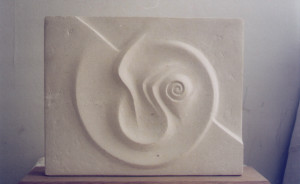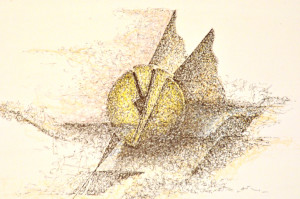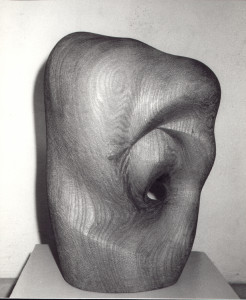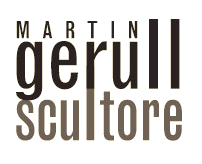PRESENTAZIONE DELL’OPERA ARTISTICA DI MARTIN GERULL
Nel mondo tutto è Forma.
Se osserviamo quanto del mondo visibile ci circonda, soprattutto in natura, ci si presentano migliaia di forme, le più varie e molteplici, mutevoli e cangianti. Se guardiamo un filo d’erba, un fiore, vediamo una forma, un colore; allontanandoci un poco, le migliaia di fili d’erba e di foglie e di fiori si confondono e si uniscono a formare un prato.
Il prato è molto diverso e fin opposto al bosco che lo circonda, ma se ci solleviamo in alto in alto (oggi si può, anche senza salire sulla montagna), prato e bosco, boschi e prati si uniscono e si mescolano a formare una distesa verde, una coperta verdeggiante che avvolge il paesaggio. Certo, il manto verde oggi, nell’epoca tecnologica, è strappato e liso, molte sono le macchie, dei territori aridi e delle città dell’uomo, ma soprattutto al manto verde fa da armonico contorno il mare.
Grandi distese d’acqua azzurra (lo è veramente, oggi, ancora?) confinano e verde e terra in forme estese e belle. Chi vola oggi a grande altezza, ai confini dell’atmosfera (lo fa l’astronauta, ma anche il viaggiatore d’aereo ne può intuire il senso) si solleva ancor più su e allora l’intero globo appare come una sfera azzurra, marezzata di acque e nuvole, con lampi e sfumature qua e là di luce calda, linee luminose che si raccolgono e si coagulano in macchie scintillanti, zolle abitate di luce operosa: sono le Città dell’Uomo.
Come dice il Faust di Goethe: “Tutto si intesse nel gran Tutto. Ogni cosa nell’altra opera e vive”. E quello che noi possiamo fare qui con il pensiero, passando dal particolare all’universale e viceversa, lo fa sempre l’uomo che osserva, che percepisce nell’esperienza quotidiana, impegnandosi a capire ciò che lo circonda, trascorrendo in un baleno dal microcosmo del suo orto al macrocosmo del pianeta
Ma questo viaggio della conoscenza, che sia consapevole o meno (per lo più in noi è inconsapevole), lo fa anche l’artista nel suo creare e in lui il percorso dalla materia all’idea e viceversa è carico di magia e mistero.
* * * * * * * * * * * *
 Facendo visita all’atelier di Martin Gerull, sistemato negli spazi della Cascina Bagaggera, all’interno del Parco di Montevecchia, si è affascinati dalla bellezza e dalla forza della natura che qui ancora è ben conservata e rigogliosa, ma anche dall’opera dell’uomo: nei casolari rustici, oggi vetusti e rovinosi, testimoni dei tempi passati e operosi, ma anche nella rinnovata presenza di attività coraggiose che testimoniano la fiducia e la fattività per il futuro: una nuova grande stalla per capre, uno spaccio di prodotti biodinamici, una cooperativa che organizza corsi feste e seminari.
Facendo visita all’atelier di Martin Gerull, sistemato negli spazi della Cascina Bagaggera, all’interno del Parco di Montevecchia, si è affascinati dalla bellezza e dalla forza della natura che qui ancora è ben conservata e rigogliosa, ma anche dall’opera dell’uomo: nei casolari rustici, oggi vetusti e rovinosi, testimoni dei tempi passati e operosi, ma anche nella rinnovata presenza di attività coraggiose che testimoniano la fiducia e la fattività per il futuro: una nuova grande stalla per capre, uno spaccio di prodotti biodinamici, una cooperativa che organizza corsi feste e seminari.
E tra tutti, appunto, le sculture di Martin Gerull. Sono, queste, moderni obelischi a scala umana, dove la forma non è perfetta geometria stellare ma dinamica ricerca del dramma dell’Io che si esprime in linee, angoli, diedri, spezzati volumi, piane superfici di forza vibrante. Oppure sono dischi marmorei poggiati sul suolo, increspata geografia in formato ridotto.
Non erano così le opere di Martin fino a un paio d’anni fa. Prima di allora la sua poesia visiva esplorava le atmosfere alte, eppur vicine e tenere, di presenze protettrici e consolanti: “il mio primo Angelo” era il motivo guida di una ricerca che anche vedeva protagonista l’Io umano, in figura solitaria o in coppia, levigata Verticale alla ricerca dell’equilibrio essenziale in sé stesso. Ma era sempre adombrato il dialogo con lo Spirito guida; finchè questo si è mostrato in una serie di gioiose apparizioni, quasi infantili, ma dolci, tenere, tonde e raggianti. Allora, l’ermetica e scostante sagoma dei fusi verticali antropomorfi chiusi in sé stessi o le colonne torcentisi e occhieggianti di nascosto si compensavano con il canto sereno e aperto delle aureole, dei raggi dolcemente orlati, dei ventagli luminosi, spiegati attorno alla Figura benefica. Un forte contrasto in opposizione che cerca dialogo tra condizione umana e grazia celeste.
Ancor prima però, riandando più indietro nelle tappe del percorso artistico di Martin, troviamo ancora dell’altro. La sua arte era ancora totalmente immersa nel fenomeno plastico come manifestazione di esseri, processi, leggi, forze generative nel puro campo ideale. Volumi, superfici, linee, spazi interclusi erano diretto apparire di fatti ideali, spirituali, soprasensibili, nella dimensione del percepibile. Certo: in talune opere si potevano vedere un torso, una vaga sagoma antropomorfa, una volontà di incarnarsi in un corpo terreno; ma era ancora tutto un esplorare la Forma galleggiando nella regione degli Archetipi in cui essa è Essenza.
Oggi no: non più.
Le sculture di Martin Gerull oggi toccano terra. Sono zolle formate che si ergono dal suolo con sforzo sovrumano; o lampi di luce condensata in roccia al momento di batter sul terreno. Se si volesse cercare una lontana parentela espressiva, con ciò che ha fatto la storia dell’Arte, della Plastica, si potrebbe trovare negli ultimissimi gesti creativi di Martin, come spunto ispirativo non come risultato formale, un’eco dello spirito dei Prigioni. Forme che vogliono liberarsi dallo stato amorfo della materia, con sforzo eroico e fin violento, ma che non sono ancora, o non sono più, sagome antropomorfe, bensì gesti esteriori nella concretezza del sensibile, che tradiscono la presenza di un Sé. Grande, efficace, attuale ritratto dell’Uomo.
Ma c’è ancora dell’altro.
Questo altro è l’interesse di Martin per la Terra. Come in un riemergere di antiche immaginazioni, compaiono nel suo atelier grandi dischi tondi dalla superficie diseguale, scabra, a zone lisce e a zone ruvide, piatte o inclinate, spezzate in spigoli netti o lievemente degradanti, trapassanti l’una nell’altra. Il materiale usato, il marmo, il gesso, la pietra tenera o il granito, nei rari casi possibile il bronzo, viene sottoposto a una modellazione per tagli netti e spaccature, come fosse soggetto a tensioni interne sottostanti, oppure per lavorazione superficiale lenta e continua che ne modifica la tessitura, la grana, la scabrosità, tra increspature e levigatezza, tra movimento ritmico ondulato o bruschi cambiamenti di andamento.
Sembra di esser di fronte come a un paesaggio, un territorio variegato e modellato da forze interne che lo piegano da dentro o da agenti esterni che lo solcano, lo trasformano da fuori. La forma del disco rimanda subito a un archetipo cosmico e la modellazione delle facce è un campionario di panorami che nell’immaginario ritroviamo sul suolo terrestre. E affiora quindi un che di arcaico, quando l’uomo antico percepiva la Terra come un grande disco piatto rotante nel cosmo, percorso da una vita interiore che ne modificava la faccia e da azioni esteriori che ne lavoravano la sostanza. Azione delle stelle e azione dell’Uomo su un Essere vivo che via via si acquietava nel suo percorso evolutivo di maturazione. Questa capacità di vedere la Terra da fuori, nell’immaginazione spirituale, come un Essere vivente, la Gaia degli antichi, è ora perduta e l’immagine stessa del pianeta è per noi cambiata, assumendo ora quella del globo sferico morto che si muove meccanicamente come il congegno di un gigantesco orologio, nello spazio. Ma un anelito nuovo è nascente oggi, di riscoprire un volto più vicino, del nostro luogo di dimora nel cosmo.
La Terra è si in trasformazione ma non solo nel senso negativo che le cronache ambientali denunciano, non solo per l’inquinamento di acqua aria e suolo, per catastrofi telluriche o alluvioni, per il comportamento dissennato o rapinoso degli uomini: è in trasformazione perché il suo corpo fisico muore. La Terra, ancora organismo vivente, si dissecca e si mineralizza per l’età, per un processo biologico ed evolutivo che attraversano tutti gli esseri viventi. Ma guardiamo al destino dell’Uomo. Con la morte fisica non termina la sua esistenza, inizia anzi una diversa superiore esistenza: Possiamo pensare anche per la Terra a questa sua vita futura?
L’artista non è solo uno specchio di ciò che esiste, dei fatti accaduti e degli avvenimenti presenti. Non è solo un “sismografo” degli spasimi del tempo: è anche e soprattutto creatore di futuro, colui che guarda e vede nel futuro. Non lo scienziato, non il politico sa che cosa avverrà, lo possono questi se sono saggi (ed oggi è una condizione rarissima, eccezionale), possono solo preparare e coadiuvare. Ma è l’artista, è il poeta colui che lo vede e lo crea fattivamente.
Sono stati Omero, Fidia, Dante, Leonardo, Michelangelo, Shakespeare, Goethe (e i loro pari) nella storia a portare avanti il mondo, non altri. L’artista è l’archetipo dell’Uomo completo, del fattore di realtà. Anche quando opera al chiuso, nel piccolo, nella modestia, ogni suo atto, se è vera arte, se soprattutto oggi è arte consapevole e non suggestione od imbroglio, se è ricerca e osservazione, precisa, necessaria, che trapassa nell’azione, ecco: lì si crea un nuovo mondo. Dal crogiuolo del nuovo artista, dell’artista-scienziato, dal suo agire consapevole (fantasia esatta), scaturiscono i fatti per nuovi mondi possibili, più essenziali, più reali, più fecondi: fantasia morale.
* * * * * * * * * * * *
Al termine della visita lasciamo Martin tra le sue figure. Forte è il contrasto tra gli edifici cadenti, resti morti di un tempo agreste strapassato e destinati a crollare, e le forme e le sculture che escono dalla sua mano. Qui nei dischi rotanti e ondeggianti, crepitanti, negli obelischi di roccia che s’ergono gridando o che si torcono possenti in moto interiore, vediamo il nuovo mondo in gestazione, in immagine. Nulla di lezioso e di carino, nulla di compiuto e di perfetto, ma vivo e fecondo, vibrante e sonante; come un neonato appena uscito dal grembo. La scultura di Martin, oggi, è questo: ansiosa ricerca del mondo; in un’immaginazione concreta tra nuovi territori geografici della plastica terrena e la presenza in fieri, baluginante e metallica, dell’Io che si forgia al lavoro sul corpo della Terra.
Qui nei dischi rotanti e ondeggianti, crepitanti, negli obelischi di roccia che s’ergono gridando o che si torcono possenti in moto interiore, vediamo il nuovo mondo in gestazione, in immagine. Nulla di lezioso e di carino, nulla di compiuto e di perfetto, ma vivo e fecondo, vibrante e sonante; come un neonato appena uscito dal grembo. La scultura di Martin, oggi, è questo: ansiosa ricerca del mondo; in un’immaginazione concreta tra nuovi territori geografici della plastica terrena e la presenza in fieri, baluginante e metallica, dell’Io che si forgia al lavoro sul corpo della Terra.
E’ questo il modello, questo che Martin Gerull cerca instancabile oggi, per la Terra futura: una figurazione della nuova esistenza, più alta e feconda, spirituale e reale della sua Essenza Cosmica e Umana. Solo l’Uomo la può ricreare con la sua opera creatrice cristificata, e traghettare al di là della morte, verso un nuovo cosmo umano-terrestre.
Come aveva intuito il nostro dimenticato grande poeta Arturo Onofri: “Zolla ritorna Cosmo”.
Milano, 28 settembre 2013.
S.Andi ( architetto, referente in Italia per l’Architettura organica vivente )
PRESENTING THE ARTWORK OF MARTIN GERULL
Everything in the world is Shape.
If we take a look at what is visible around us, most of all in nature, we see thousands of shapes, vastly different, multiple, changing, shifting shapes. If we look at a single leaf of grass, a flower, we recognize a certain shape, a certain color; if we take a step further, thousands of grass leaves and flowers get together and mix into a beautiful lawn.
A lawn is highly different than, even the opposite of, its surrounding woods. Yet, if we reach higher and higher (nowadays we can, without even having to climb a mountain), lawn and woods, grass and forests melt into a vast green blanket embracing the landscape. Sure, today during our high-tech times, such green surface is always rarer, eaten away by the spots of dry land and urban settings, but most of all green lands are tenderly outlined by the sea.
Wide blue water seas (are they, still today?) dance around green and brown earth, painting an extensive, breath-taking canvas. People who fly at exceptional heights, close to the atmosphere (i.e. astronauts, but also airplane flyers may get the sense of it) are able to get an even higher perspective: the entire globe becomes a light blue sphere with blue seas and clouds, bolts and delicate hues of warm light here and there, luminous threads leading to sparkling centers, lands inhabited by laborious light: they are the Cities of Man.
Like Goethe’s Faust used to say: “Everything is connected in the great All. Everything operates and lives in the other”. And what we can do here with our thought, passing from the detail to the universal and the other way round, that is the work of those who observe, who feel their daily experience, those who strain to understand what is around them: passing from the micro-cosmos of their garden to the macro-cosmos of the planet in a heartbeat.
 Yet. Whether conscious or not (most of the time it is not, for us), this journey of knowledge is experienced by the artist when he creates, and to him the thread leading substance to idea and vice versa is full of magic and mystery.
Yet. Whether conscious or not (most of the time it is not, for us), this journey of knowledge is experienced by the artist when he creates, and to him the thread leading substance to idea and vice versa is full of magic and mystery.
**************
Located at Cascina Bagaggera, within the Park of Montevecchia (near Milan, Italy), paying a visit to the atelier of Martin Gerull you are astonished by nature’s beauty and power, here still well preserved and thriving, as well as by man’s work: now old and in ruins – mirrors of ancient, laborious times – country houses still reveal the renewed courage of activities that show faith in the future. A new, huge goat barn, a store selling biodynamic products, a co-op organizing courses, events and workshops.
And among all this, the artwork of Martin Gerull. They are modern obelisks on a human scale, where shape is not perfect cosmic geometry, but dynamic research of the drama of the I manifested through lines, angles, dihedrals, broken volumes, plane surfaces made of vibrating power. Or they are marble disks standing on the ground: wrinkled geography on a small scale.
But Martin’s artwork was not like this until a couple of years ago. Until then, his visual poetry was exploring high atmospheres, though close and tender, of protecting and consoling figures: ‘il mio primo Angelo’ (my first Angel) was the Leitmotiv of a search also focusing on the human I, lonely or in couple, a smooth vertical trying to reach for essential balance in itself. Yet, communication with his guiding Spirit has always been in shadow, until the Latter showed its presence on different, joyous, almost childish occasions, through sweet, tender, round and radiating traits. Then, the hermetic, rough shape of anthropomorphous verticals – closed in themselves – or the turning columns bearing mysterious eyes were compensated by the peaceful, open song of aureoles, of softly edged rays, of bright fans opening around the beneficial Figure. A massive opposing contrast searching for a dialog between human condition and celestial grace.
Still earlier, tracing back the previous stages of Martin’s artistic path, we find something different. His art was still thoroughly deep in plastic expression, as a way of manifesting being, processes, generating laws in pure ideal terms. Volumes, surfaces, lines, inter-secluded space were direct manifestation of ideal, spiritual, supersensible facts in a perceptive dimension. Sure: in certain art works you could see a torso, a hint of an anthropomorphous shape, a will to incarnate into an earthly body; but more often it was about exploring Shape by floating through Archetypes where it is Essence.
Not today: not anymore.
Today, Martin Gerull’s sculptures touch the ground. They are well-defined clods raising from the ground through superhuman efforts; or flashes of light condensed in stone while hitting the ground. If we looked for a remote expressive connection with what we find in the history of Art and Plastic, in Martin’s latest creative gesture we find an echo of the Prisons’ spirit, more as inspiration traits rather than formal results. Shapes long to get free from the substance’s amorphous state through heroic, even violent effort, yet they are not anthropomorphous yet, or not anymore, but exterior expressions of sensible reality, betraying the presence of Self. A great, effective, contemporary portrait of Man.
But there is more.
And that is Martin’s interest for the Earth. Like ancient pictures resurfacing from the past, in his atelier we see huge, round obelisks with irregular, rough surfaces, smooth alternated with rough, flat or inclined, broken in clear angles or gently degrading, piercing one into another. Marble, plaster cast, soft stone or granite, in rare possible cases even bronze, the employed material is modeled by clear cuts and splitting as if subject to an underlying inner strain, or by slow, constant surface processing modifying texture, grain, roughness, between ripples and smooth areas, rhythmic, undulated flows or sudden changes of direction.
It seems like we are looking at a landscape, a mixed land modeled by an inner power which bends it from the inside, or by external factors which plough it from the outside, changing it. The shape of disks immediately brings back to a cosmic archetype and the modeling of faces is a collection of landscapes which, in our imagination, we can locate on earthly grounds. Something archaic resurfaces, when the ancient Man perceived the Earth as a huge flat disk rotating in the cosmos. When the Earth’s inner life modified its surface and external actions modeled its substance. That was the action of stars and Man on a living Being, but the Gaia of ancient men has now got lost, and the image of the planet itself has changed for us, morphing into a dead spherical globe moving mechanically through space like the operating device of a huge clock. Yet, today a new longing is coming along: the longing to rediscover a closer face of our home within the cosmos.
The Earth is changing, but not only in the negative way environmentalists report, not only for its polluted water, air and soil, for telluric catastrophes or flooding, for Man’s unreasonable, plundering behavior: it is changing, indeed, because its physical body is dying. Still a living organism, the Earth is drying up and mineralizing by age, because of a biological evolutionary process all living creatures go through. But let us take a look at Man’s destiny. Through physical death, his existence does not come to an end, on the contrary, it marks the beginning of a different, superior life: are we able to think of such a future life also for the Earth?
The artist is not only a mirror of what already exists, of already occurred facts and present events. He is not only a “seismograph” of time’s agonies: he is also, most importantly, a creator of the future, the one who looks into and sees into the future. He is no scientist, no politician who knows what is going to happen – only the wise ones can (and today, that is an extremely rare, exceptional condition) – they can only prepare and help. It is the Artist, the poet who sees it and creates it in practical terms.
It was Homer, Phidias, Dante, Michelangelo, Shakespeare, Goethe (and their equals) in history who carried on the world, not the others. The artist is the archetype of the complete Man, the maker of reality. Even when he operates in closed, small, modest environments, every each and one of his actions – if it is true art – and most importantly today, if it is conscious art and not suggestion or fraud, if it is accurate, necessary research and observation trespassing into action.. then, right there a new world is being created. From the melting pot of the new artist, the artist-scientist, from his conscious action (exact imagination) are born facts for new possible worlds, more essential, more real, more fertile: moral imagination.
*******************************
At the end of our visit, we leave Martin to his creations. Dead remains of long-ago rural times, doomed to fall, our eyes meet a massive contrast between decadent buildings and the shapes and sculptures modeled through his hands. Here, in his rotating, floating, lively disks, in his stone obelisks standing straight, screaming, or turning in powerful inner motion, we see the new world rebirthing, in pictures. Nothing fancy, cute, nothing complete nor perfect, yet alive and fertile, vibrating and loud; like a newborn who has just gotten out of his mother’s womb. Today, Martin’s artwork is this: anxious search for the world; in a substantial imagination between the new geographical territories of earthly plastic and the presence of the I – flickering and metallic – forging himself for his work on Earth’s body.
This is the model, this is what Martin Gerull is tirelessly looking for today, for the future Earth: a higher, more fertile, spiritual and real representation of its new existence, of its Cosmic and Human Essence. Only Man can recreate it through its christified creative work and lead it beyond death towards a new human-earthly cosmos.
Like the great, forgotten Italian poet Arturo Onofri had sensed: “Soiled returned to the Cosmos”.
Milan, September 28, 2013.
Stefano Andi
